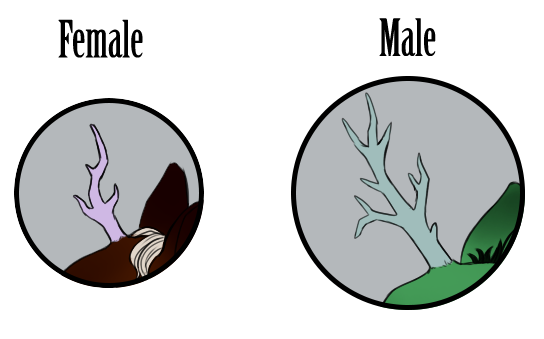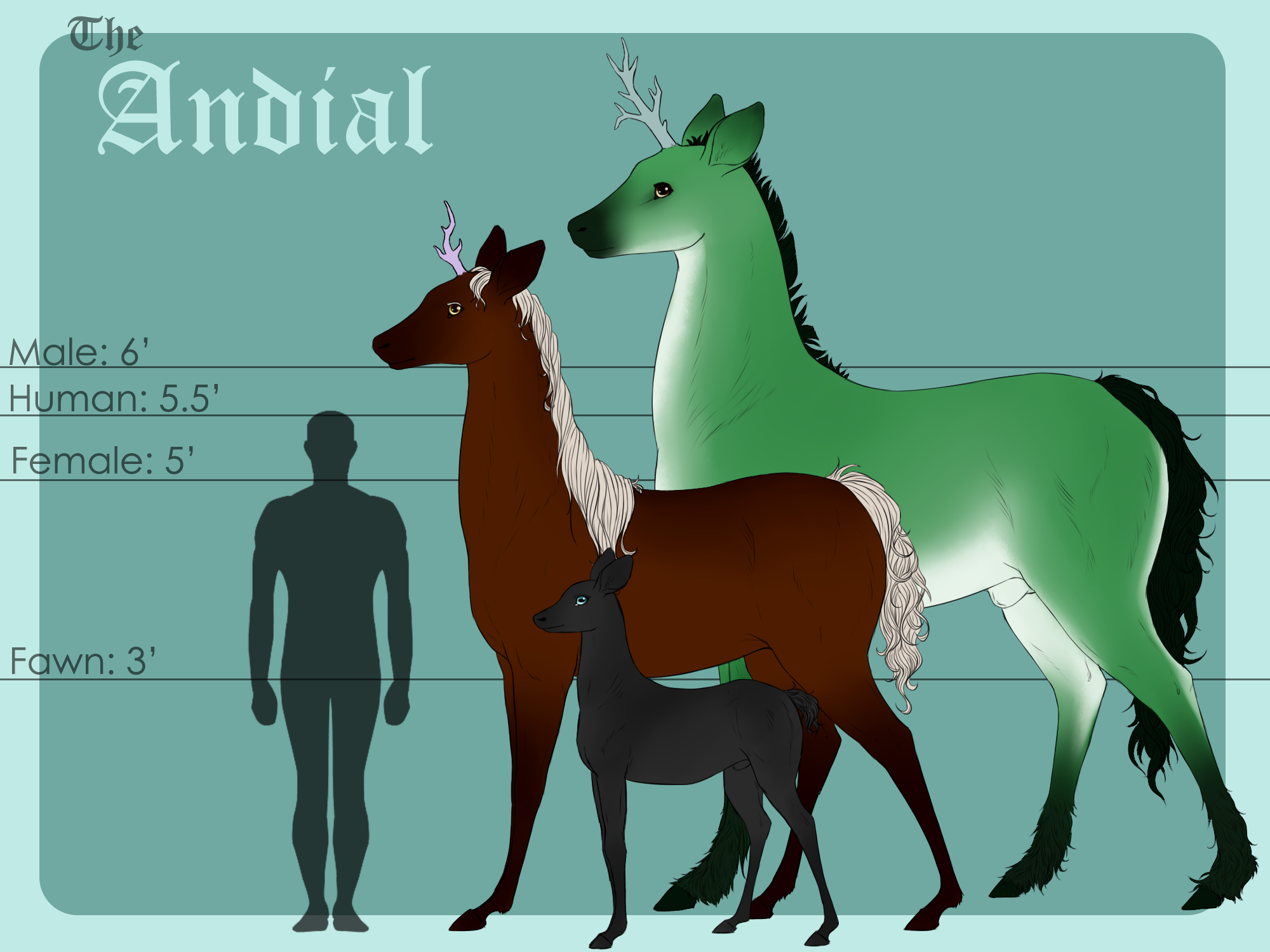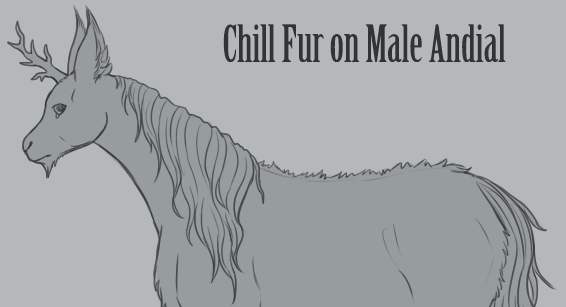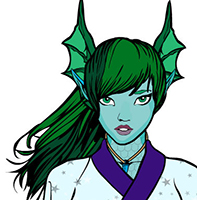Andial
Though he knew even the fawns were large enough to knock him over in a moment, they seemed as though they could float on their hooves, moving over the ground with a gait so smooth and graceful they barely bounced. It was difficult to imagine a clumsy Andial, despite their massive size. One of them seemed vaguely interested in him, but the moment he took a step towards it, the doe decided she had better things to do, and quickly stuck her nose in the air before galloping off to join the rest of the herd.
Basic Information
Anatomy
Andials are massive, deer-like ungulate mammals with a singular, branching, crystal-like horn. Andials have four long, slender legs, large ears, and large, wide-set eyes. Manes and tails grow out naturally long, and their bodies are covered with short, smooth fur. The snout of an Andial feels almost like velvet.
Their horns are hard and often kept sharp and jagged. The bases are firmly set in their skulls so their horns can be used as defense, whether it be via battering or lunging stabs. Their hooves are quite hard and sharp as well, and can do extensive harm. Their hooves have small, sharp spike-like bumps on the bottom that help with traction and defense. Though Andials are herbivores, their front teeth are flat and almost chisel-like to easily tear heavier foliage.
Biological Traits
Female Andials tend to be smaller than males, often by quite a bit. Female horns tend to grow slower and branch less, and they also tend to mature sexually later than males. The fur around a male's legs grow longer and thicker, thought to be protection while fighting. Andials that live in the mountains or in colder areas tend to be slightly smaller and have thicker fur, while those that live further into open areas are larger and have less fur.


by Ame Blue
Genetics and Reproduction
Female Andials have one heat a year, and during this heat males will begin competing with each other by bringing the female food, fighting each other, chasing away predators, or knocking over trees. The average male Andial will cover two or three females during a season. Lead Andials (those who lead herds) can sometimes cover up to six females in one season if they are healthy enough and their herd is large enough.
Once a female has been impregnated, the gestation period is about eight months. Andials will have one or two fawns, and these fawns will remain close to their mother until they are a year old.
Growth Rate & Stages
When Andials are first born, they can be standing within hours. They are born without a horn, and are stuck to their mother's side from birth. While a fawn is still small, their hooves are not hardened completely, and the bumps on the bottom of their hooves that will act like cleets when they're older have not quite grown in completely yet. Their muzzles are very small and are used to root around in the ground for roots, mushrooms, and grass.
Andials stay right beside their mother until they are four months old, at which point they will begin to wander through the herd and explore their world more eagerly. Their horns begin to emerge at six months, and their hooves have hardened completely at this point. Fawns begin to move to leaves and will try to snag branches that the adults drop. Once they are a year old and only slightly smaller than they will be at their full size, they act as singular members of the herd, no longer forced to stay at their mother's side.
At two years old, they are full size and their horns have fully grown in. Some males will leave their herd and join bachelor herds, made up of young male Andials looking to create their own herds. Females will often stay with their birth herd until they are old enough to breed at four years, at which point they either mate with a male from their birth herd or will mate with a male from another herd and join that one.
Ecology and Habitats
Andials spend most of their time in hilly forests and wide, open plains. They will usually follow rivers through their territory, which can be several hundred miles and overlap with other herds. They spend most of their time grazing or searching for berries and fruits in plants. They can travel up to 50-60 miles a day if needed, but more often than not they will travel at a leisurely 15 miles a day.
Throughout the year, Andial herds follow a path in their territory that stretches up into the mountains and down into the plains. During Chill, Andials will move into forests and use their hooves to dig for roots and surviving plants buried under the snow, as well as feed on any tree leaves that have survived. During Rain, herds will move into the mountains to avoid flooding in lower areas. Growth draws the Andials back out to the plains, where most fawns are born to an abundance of food. Herds will stay in the plains through Dry and their breeding season, which is in Wilt, until Chill comes back around and they head into the forests once more.
Depending on their geographic location, some herds will forego the mountains completely if they are high enough to not worry about flooding, and others who are at a lower elevation might spend most of their time up in the mountains.
Dietary Needs and Habits
Andials are herbivores, and their diet is made up of mainly grass, hay, berries, fruits, leaves, and flowers, though they can eat treats of nuts, non-toxic mushrooms, and vegetables. Andials will spend most of their time grazing or foraging for snacks. Though they aren't protective over certain areas of food, Andials will 'guard' things they've deemed treats by bumping others out of the way with their rump as they feed.
Fawns use their small muzzles and delicate hooves to dig into the ground for roots, grasses, and mushrooms. They move onto leaves and foliage as they get older, and once they're full grown they can reach trees and will begin to eat branches.
Andials have been witnessed eating hallucinogenic mushrooms purposefully, and seem to enjoy doing this in groups. There are usually several Andials who will not participate in order to keep the herd protected and those who are intoxicated safe.
Biological Cycle
Once a year, Andials will begin scraping their horns against trees and rocks and shards of it will break off; this is known as sharding. They do this to keep their horns sharp for defense, and also keep it under control, as their horns never stop growing and branching. As such, they need to be able to break off length and branches that are growing in a way the Andial doesn't find comfortable. Their horns are very similar to quartz, and these shards are often sought eagerly by many for their beauty. Sharding often happens during Rain, when most herds are up in the mountains and can break their horns off on easily found stone.
When Wilt begins and the world gets colder, Andials' fur will thicken, leading to small beards on the males and fur ridges along their backs. Their ears become so furry that they seem to be larger and more pointed.
Additional Information
Domestication
Andials were domesticated from before the Borders were created. Because of their size, they were largely unconcerned with humans, who found them too dangerous to hunt. Andials and humans grew closer and closer until it was found that Andials, when born close to humans, would imprint on one person, and became easy to train. From there, they were bred into domestication.
Because of domestication, Andials' colors are often brighter and more saturated, and their manes and tails have become longer. Their horns tend to grow more rapidly as well, which means they are almost constantly rubbing their horns on something to get stray shards off. Oftentimes owners will provide specially made posts for Andials to break stray branches or length off on. Their lifespan has greatly increased due to the lack of predators and better treatment for illnesses.
Uses, Products & Exploitation
Andials are often difficult to hunt because of their herd mentality, speed, size, and intelligence. However, wild Andials are hunted for sport in some Provinces for cultural reasons. Their horns are often made into weapons or jewelry. Andial pelts are quite soft, so these are often used to create coats and blankets.
The main use of Andials for people are travel; they are large enough to pull heavy carts, and are protective of their owner once they've become attached so they make good travelling companions. Caravans of nomads have been known to travel with an entire herd of Andials, some of which pull carts and others that will just walk with the caravan. Andials' use for travel isn't as needed in more developed provinces that have faster and more reliable forms of transportation.
Because Andial horns are sensitive to changes in pressure, temperature, wind speed and direction, humidity, and some other qualities, Andials are the most accurate way to predict weather. Some Andials are specially bred specifically for this purpose, and are trained from a young age to make clear behavioral signs depending on the approaching weather.
Some Andials are used to show in competitions, which range from skills like endurance racing and show jumping, to creative dance-like competitions like dressage and liberty, to shows of strength like hauling and cart racing.
The most famous example of Andial use is the Andalan Shard, a massive estate that acts like a small town. Every employee lives and works at Andalan Shard, where they breed, train, show, and provide medical treatment to Andials of all sorts. Andalan Shard also provides rehabilitation for wild Andials that have been injured, or require medical attention. Reintroduction happens almost 70% of the time.
Geographic Origin and Distribution
Andials have been bred so extensively that they are in nearly every Province. For reasons unknown, Andials are also Borderless, and can cross the Borders without issue. Andials will stay out of any desert areas, and trend towards plains, forests, and small mountains. Because of Cabres being abundant on the continents of Moldars and Grieltot, Andial populations are thinner in these areas, and their lifespans are shorter.
Average Intelligence
Andials are quite intelligent for an animal, and are known for their problem-solving skills. They've often been found working together to retrieve tasty treats such as hard to reach fruits, or knock over trees in order to cross dangerous rivers. They can understand simple commands and hand motions and have excessive memories, to the point they can remember people, places, or other animals they haven't met in years. This can cause problems in captivity, as locks often have to be complicated or unreachable in order to keep Andials in stalls. They need a large selection of enrichment activities and items to keep them properly entertained.
Perception and Sensory Capabilities
Andials' massive ears and wide eyes allow their hearing and seeing to be exceptional, with a very small blind spot directly in front of and behind them. Their hearing can reach up to two miles away. Their crystal horns can pick up vibrations in the air and changes in the atmosphere, allowing them to be better at predicting the weather than most technology.
Lifespan
40 years in captivity; 15-25 years in the wild
Average Height
Male: 5.5 - 6.8 feet
Female: 4.8 - 5.4 feet
Average Weight
Male: 800 - 1,300 lbs
Female: 400 - 800 lbs
Body Tint, Colouring and Marking
Andials are colorful, with almost every color being bred into the species thanks to hundreds of different breeding programs. Wild Andials tend to be less saturated, staying in the browns, blacks, and grays. Markings tend to vary greatly depending on genetics and breed. An Andial's skin is always darker than its fur color, leading to what appears to be a fade most commonly on the muzzle and legs. White markings will always have pink skin under them, with few exceptions that cause gray or blue coloration.








Alright, first of all: I like this article. To me, it seems very concise and gets a lot of mileage out of the stunning artwork you created for it. I supposed I could point out a lot of things you could still write about such as seasonal migration patterns, unusual behavior (like eating rotten fruit to become drunk), how humans exactly use the andial to predict the whether (if they are utilized this way), and more. But of course, that is just about writing more, which can be done at any time ^-^ Instead I am going to point out how you can easily polish what you have written already a little: As I said you get a lot of mileage out of your image with the text, but you should also try to get more out of the image itself. I have re-purposed many of my materials over the course of my moth article, and your article too could profit from more images. An example for this would be using parts of your image to highlight the differences between male and female andial inside the corresponding article section ("Biological Traits"). Here is an example graphic I created with your image: https://www.worldanvil.com/i/40864 The great thing about graphics such as this is - they aren't a lot of extra work, but their impact on the article's appeal is tremendous! Keep writing, this was great, and I hope to see more ^-^
I have no doubt that the award for most words next WorldEmber will be yours Koray :P
World Anvil Founder & Chief Grease Monkey
Twitter | World Anvil Changelog
“No act of kindness, no matter how small, is ever wasted.” - Aesop
And this is a compliment. Your articles are amazingly crafted pieces of fiction.
World Anvil Founder & Chief Grease Monkey
Twitter | World Anvil Changelog
“No act of kindness, no matter how small, is ever wasted.” - Aesop